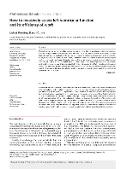How to invasively assess left ventricular function and its efficiency of work

Publication date
2024Published in
Cor et VasaVolume / Issue
66 (1)ISBN / ISSN
ISSN: 0010-8650ISBN / ISSN
eISSN: 1803-7712Metadata
Show full item recordCollections
This publication has a published version with DOI 10.33678/cor.2023.080
Abstract
Effective performance of the left ventricle requires the maintenance of a cardiac output as demanded by the systemic circulation without a high hemodynamic cost or pressure and without a high metabolic cost or oxygen demand by the left ventricular myocardium. In this article the left ventricle is considered as a pump and performance is based on evaluation of measurements of its pressure, volumes, and flow. Analysis of ventricular function in terms of pressure-volume relationships allows global and regional ventricular dynamics to be fully analyzed and relatively easily and precisely obtained with conductance catheter. The maximum rate of left ventricular pressure is classically considered as a marker of left ventricular contractility and in specific situation arterial dP/dtmax, as minimally invasive method, can be an alternative. When assessing new pacing techniques and cardiac resynchronization therapy, invasive systolic blood pressure appears to be the most practical measure with multi-beat averaging and the addition of multiple spaced repeated alternations.
Keywords
Cardiac function, dP/dtmax, Hemodynamics, Performance of heart, Stroke work
Permanent link
https://hdl.handle.net/20.500.14178/2544License
Full text of this result is licensed under: Creative Commons Uveďte původ-Neužívejte dílo komerčně 4.0 International






